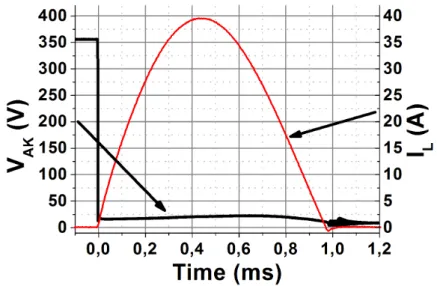HAL Id: hal-00747341
https://hal.archives-ouvertes.fr/hal-00747341
Submitted on 29 Jun 2019HAL is a multi-disciplinary open access archive for the deposit and dissemination of sci-entific research documents, whether they are pub-lished or not. The documents may come from teaching and research institutions in France or abroad, or from public or private research centers.
L’archive ouverte pluridisciplinaire HAL, est destinée au dépôt et à la diffusion de documents scientifiques de niveau recherche, publiés ou non, émanant des établissements d’enseignement et de recherche français ou étrangers, des laboratoires publics ou privés.
Pulse characterization of optically triggered SiC
thyristors
Nicolas Dheilly, Gontran Pâques, Sigo Scharnholz, Dominique Planson
To cite this version:
Nicolas Dheilly, Gontran Pâques, Sigo Scharnholz, Dominique Planson. Pulse characterization of optically triggered SiC thyristors. International Conference on Silicon Carbide and Related Materials 2011 (ICSCRM’2011), Philipp Neudeck, Sep 2011, Cleveland, United States. pp.FR-1A-3. �hal-00747341�
Pulse characterization of optically triggered SiC thyristors
Nicolas Dheilly
1, a,*, Gontran Pâques
2,b, Sigo Scharnholz
2,cand Dominique
Planson
1,d1Université de Lyon, INSA de Lyon, Ampère, UMR 5005, 20 avenue A. Einstein, F-69621
Villeurbanne Cedex, France
2French-German Research Institute of Saint-Louis (ISL), France anicolas.dheilly@insa-lyon.fr, bgontran.paques@isl.eu, csigo.scharnholz@isl.eu
ddominique.planson@insa-lyon.fr,
To further improve the performance and to reduce weight and volume of switches developed for future electromagnetic weapon and protection systems, research laboratories like ARL or ISL evaluate the pulsed power capability of SiC thyristors [1, 2]. In the field of pulse power electronics, the thyristor is best suited because of its high blocking voltage and high current handling capability due to the bipolar conduction.
We have lately demonstrated the light triggering of SiC thyristors with a UV LED [3, 4]. The advantages of the light triggered thyristor (LTT) are the galvanic isolation of the driver and the reduction of EMI interferences which is interesting for high voltage systems. A second run of LTT has been designed and fabricated. This paper reports on the evaluation of these devices for pulse power applications.
Two samples of 1 cm by 1 cm were used two fabricate 16 thyristors on each. An etched edge termination was used to avoid ion implantation. The maximum blocking voltage measured on these devices was 6300 V. Some thyristors were then bonded with 25 µm diameter gold wires to perform switching and pulse measurements.
Characterizations with a short (10 µs width) and a long (650 µs width) current pulse were performed. To proceed with the short pulse measurement, a thyristor was used to control the discharge of a capacitor through a shortcut. The schematic of this experiment is depicted in figure 1. Thyristor current and voltage waveforms resulting from this discharge are shown in figure 2. Several successive pulses were applied to the device, increasing between each shot the capacitor charging voltage. The device under test was able to generate current pulses having a peak value of up to 156 A. This value corresponds to a current density of 15.6 kA.cm-2 in the active area. After this last pulse, the device was not able to switch on again. A possible explanation is the bipolar degradation of the device due to the high current density that occurred.
To carry out long pulse characterization, the discharge of the same capacitor in an inductive load was studied. The schematic of this experiment is shown in figure 3. Three diodes were included in the circuit in order to avoid reverse current to flow in the thyristor and to limit the reverse voltage applied to the thyristor. With a capacitor charging voltage of 355 V, a peak current of 40 A was reached, corresponding to a current density of 4 kA.cm-2. Eleven successive pulses, similar to the one represented in figure 4, were generated by triggering the thyristor. This experiment has led to the destruction of the metallization and of some of the wire bonding connections.
In the final paper, further details will be given on the fabrication of the thyristors and on the experimental results. More short pulse characterizations will be shown, focusing on the influence of the high current density on the on-state characteristic, in order to illustrate the bipolar degradation of the device. Concerning the long pulse, we will probably present results of further thyristors, connected with 50 µm diameter bonding wires to investigate if it improves their reliability. The results will also be compared to similar experiments published by others.
[1] Heather O’Brien et al, IEEE Trans. on Magnetics 45(1), pp. 402 (2009) [2] S. Scharnholz et al., Materials Science Forum vol. 679-680, pp. 682 (2011) [3] N. Dheilly et al., Material Science Forum, vol. 679-680, pp. 690-693 (2011)
[4] N. Dheilly et al., Electronics Letters, vol. 47, no. 7, pp. (2011)
Acknowledgements: Part of this work was supported by the French Defence Procurement Agency (DGA) and the French-German University (DFH-UFA) under contract no. G2RFA-106-07.
Fig. 1. Schematic of the experiment for the short pulse characterizations.
Fig. 2. Voltage and current waveforms of the thyristor during short current pulses.
Fig. 3. Schematic of the experiment for the long pulse characterizations.
